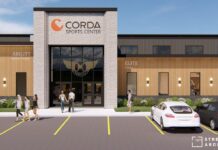by Bekah Porter
CEDAR RAPIDS – Closing a portion of Second Avenue for a proposed medical mall would not significantly impact drivers.
Such was the message delivered by engineers this past week during two community meetings where the public continued the debate surrounding the facility that medical officials say would help turn the city’s dream of creating a thriving medical district into a reality.
The conversation started this past year when the town’s largest physician specialty group, Physicians’ Clinic of Iowa (PCI), announced a plan to build a medical mall on 10th Street and Second Avenue.
However, PCI officials noticed a snag in the plan — the 200,000-square-foot facility could not efficiently fit into a city block.
So they offered a solution — close the portion of Second Avenue between 10th and 12th streets.
Since April, the Cedar Rapids firm of Anderson-Bogert Engineers & Surveyors Inc. has been conducting a traffic study where workers examined key intersections approaching the area along Second Avenue and 10th Street, as well as the many intersections within the district. The firm made these results public at the recent meetings.
“What we’ve found thus far is that while shifting the traffic will have an impact, it would result in maybe an extra 30 to 40 seconds of travel time along First Avenue between Fifth Street and 15th Street,” said Jeffrey Morrow, with Anderson-Bogert.
Other findings included:
Traffic volumes on Second Avenue have decreased substantially since 1978, with the road providing service to less than one-quarter of the traffic that is on First Avenue
Second and Third Avenues could handle three times their current respective traffic loads of 5,153 vehicles and 6,478 vehicles daily
First Avenue could handle 30 percent more traffic
He also said that Second and Third Avenues are currently underutilized, as the traffic approaching the medical district comes from different roads, including
17 percent of traffic approaching the medical district comes from Interstate 380
15 percent comes from the south on First Avenue
18 percent comes from the north on First Avenue
13 percent comes from Mount Vernon Road
15 percent comes from the south on Eight Avenue
This comes largely because the roads were built in the 1950s and 1960s.
“That was a time when we had a lot of retail in the downtown, so therefore, there was a lot of traffic in the downtown,” he said.
That changed, and the city converted what were all two-way traffic roads into one-way streets.
Now, only one of 24 intersections has what the firm classifies as a “poor level of service,” meaning that it has a lot of traffic. The remaining intersections have few cars traveling on them.
Based on these findings, the firm came up with some suggestions, including two scenarios.
In the first scenario, the city would redirect Second Avenue traffic to First Avenue by:
Closing Second Avenue between 10th and 12th streets
Converting Seventh and Eighth streets into a two-way traffic street between Third and Eighth Avenues
Converting Fourth and Fifth avenues into a two-way traffic street between Fifth and 14th streets
Converting 10th Street into a five-lane traffic street between A and Eighth avenues
In the second scenario, the city would redirect Second Avenue traffic to Third Avenue by:
Closing Second Avenue between 10th and 12th streets
Redirecting traffic from Second Avenue onto Third Avenue, which is converted into a two-way traffic street between Fifth and 15th streets
Converting Seventh and Eighth streets into a two-way traffic street between Third and Eighth avenues
Converting Fourth and Fifth avenues into a two-way traffic street between Fifth and 14th streets
Converting 10th Street into a five-lane traffic street between A and Eighth avenues
The first scenario, which involves redirecting traffic onto First Avenue, would cost about $2.6 million and would cause a slight increase in traffic near I-380 access and would leave little capacity to accommodate traffic volume for future growth, according to the engineering firm.
The second scenario, which redirects traffic onto Third Avenue, would cost about $4.5 million and would result in no significant short-term impact, would slightly increase traffic near the I-380 access and would provide more capacity to accommodate traffic volume for future growth.
At the public meetings, community members were given a handout that asked several questions, such as, “What do you think about the potential traffic changes need to accommodate the envisioned medical district?” and “What do you think about the medical district as a driver of economic development for Cedar Rapids?”
This feedback will be given to the city on Aug. 10 with a complete copy of the traffic study. The city council will hold an Aug. 24 public hearing to review PCI’s request to close a portion of Second Avenue. CBJ




